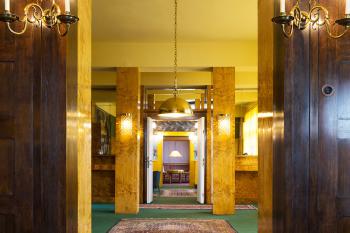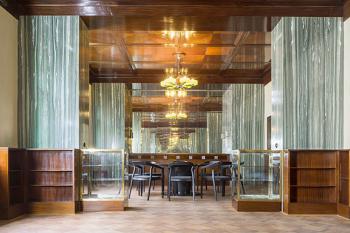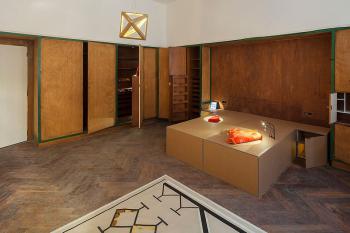The September opening of the permanent exhibition of the surviving work of Surrealist painter Edita “Tita” Hirsch in the Brummel House in Plzeň served, as well, as the culmination of the final stage of restoration work of the building, now the most important Plzeň landmark in the oeuvre of Adolf Loos.
Tita, a member of the French Surrealist group La Main à plume who perished in September 1942 in Auschwitz, was a frequent guest in the Brummel House in the early 1930s before her departure to Paris (more extensive information on this unjustly forgotten artist was presented in AA 9/2009 on the occasion of the publication of Anna Pravdová’s book Overcome by Night). She was linked to Loos’s Plzeň clients, brothers Jan and Leo Brummel, through family connections on her mother’s side. The presentation, prepared by National Gallery curator Anna Pravdová and architect Hedvika Marešová, presented not only Tita’s work but also a revitalisation of the careful restoration of the house’s interior, which even today reflects the cultural ferment in the social medium that provided Loos with his clients.
Loos’s architectonic realisations in Plzeň represent a phenomenon that has recently achieved notably greater awareness among enthusiasts for modern architecture. “The group in Plzeň is, both in terms of numbers and extent of preservation in the original context, unique, and in certain parameters exceeds even Loos’s best-known site of activity, Vienna,”, stated one of the world’s leading experts on Loos’s architecture during his recent Plzeň visit, Professor Christopher Long from the University of Texas at Austin, the author of several books on the architect, including The Looshaus. This recent establishment of Loos’s predominantly interior-based work in Plzeň at the boundary between cultural and historical memory, in connection with touristic interest, urges us to think more about the future of the Plzeň oeuvre and the methods of its presentation.
As one of the great pioneers of Modernist architecture, it is hardly necessary to give Adolf Loos an extensive introduction. Though he never completed any of his architectural studies, he became – particularly after World War II – an icon of international architecture. Yet, while the Western world began to take an interest in Loos’s achievements by the end of the 1950s, the study of this work in socialist Czechoslovakia was consigned to a semi-illegal periphery. The Plzeň group, in fact, was only presented to the world by art historian Věra Běhalová in an article published in Austria following her emigration in 1968.
A native of Brno and later a citizen of Czechoslovakia, though in his own words primarily a European, Adolf Loos began the first of his Plzeň interiors at the start of the 20th century at the initiative of the wealthy industrialist family of Hirsch, in this case at the address Plachého ulice 6. Only a few years later, friends of the Hirsch family, the family of Otto Beck, requested Loos to design an interior practically around the corner, at the current address of Klatovská třída 12. When the Beck family decided to move the fittings of this flat to a new address in the same city in 1928, a certain understanding emerged between Loos and the daughter of his client, Clara, leading to their marriage in 1929.
At the end of the 1920s, Loos enriched the architectural environment of Plzeň with further realisations in the second, more prolific era of his work, ending only with his death in 1933 in the sanatorium of Kalksburg near Vienna. Loos’s Plzeň clients consisted of a network, connected through family or professional ties, of prosperous and culturally advanced Jewish families. Nonetheless, this last period could truly be termed the architect’s swan song: as his health worsened, he was forced increasingly to rely on his assistants, in his Plzeň work primarily Heinrich Kulka and Karel Lhota.
Expert analyses have discerned certain parallels to the preparation of Loos’s masterwork, the Villa Müller in Prague, in certain architectural solutions in the Brummel House in Plzeň. Even more notably, the plans for the Villa Müller were created in the ateliers of the construction firm of the client, Müller & Kapsa, which was then located on Plzeň’s main square, náměstí Míru. Loos’s highly informal working methods, using rapidly sketched outlines even on such unusual surfaces as a paper flour-sack, followed by assigning the detailed preparation of blueprints and communication with public officials to the architect’s assistants, now makes clear identification of his works somewhat difficult: attributions are forced to rely on examination of archival plans and correspondence, as well as technological investigations on site – to discern the materials and methods that Loos used repeatedly. At present, it is estimated that around fourteen realisations of Loos were completed in Plzeň, primarily interiors, and around half of them survive, in varying degrees of preservation, to the present. Of this number, four interiors are now, thanks to the care of the City of Plzeň, accessible to the public.
Three of the publicly accessible interiors offer the informed visitor as well several different approaches to restoration and presentation. Here, an exceptional role is played by the previously mentioned Brummel House at Husova ulice 58, close to the central bus station. As a building where both Loos and Lhota worked on the exterior design, this landmark is Plzeň’s sole instance of a façade design by Loos. Currently, it is part of the Iconic Houses Network, an international group of important publicly accessible dwellings from 20th-century architecture.
Originally a two-storey suburban house of late 19th-century date and situated in an industrial area of the city, it was rebuilt at the request of clients Jana and Jan Brummel, in 1928–29 and a three-level rectangular addition joined to it. At the recommendation of the city construction office, the façade was made unified, so that now, viewed from Husova, it forms a kind of modernist backdrop to the earlier section. While the ground floor was occupied by a rented flat and the garage of the Brummel company, a dealer in construction timber, the upper floor is where Loos designed a uniquely composed interior space.
Using the principle of the enfilade, an element that Loos took from aristocratic residences, the design allows a vie practically uninterrupted through the entire building, from the bracketed terraces up to the bedroom of Hedwig Liebstein(ová), the mother of Jana Brummelová. To one side of this axis lie the private spaces, such as the bedroom of the young married couple, connected to a garderobe and bath. Despite many threats – confiscation under the Nazi occupation of the Czech lands, the Allied bombing raid against the nearby Škoda engineering works in April 1945, nationalisation in the 1960s or plans to demolish the house in entirety during construction of the bus station – the Brummel House today represents the most authentic work by Loos that Plzeň has to offer.
Through the care of the family, the original furniture has survived, including the pieces designed by Loos himself. Detailed photographic documentation has only reinforced the quality of the restoration of the extensive surviving originals. Worthy of particular emphasis is the role of the nephew of the builders, the house’s current owner Michal Brummel, who since acquiring the property in the post-Communist property restitutions of the 1990s has always worked towards his dream of restoring the house and opening it to the public. The restoration project was created by the Prague atelier of Václav Girsa, who also assisted in the restoration plans for Prague’s Villa Müller.
Girsa and his team also designed the restoration of Loos’s interior of the flat for the young couple Vogel at the address of Klatovská třída 12. Currently, the core of this 1929 interior is formed by the former living room with a small dining room adjoining it; the remainder of the flat, which originally occupied the entire floor, disappeared during the building’s adaptation for offices, a process that began immediately after the confiscation of the property under the Nazi occupation. What allowed these rooms to survive was their status as ‘such a nice space’ suited for the ‘boss’s office’ or a representative conference room. Preserved elements from the original interior include the cherry-wood panelling, the marble pilasters and the gas fireplace. The attached dining room, which without any exaggeration is one of Loos’s most beautiful interiors, has in turn interesting panelling from travertine.
Girsa’s atelier made exceptional use of the surviving photographs taken by Loos’s assistant Karel Lhota in 1930, using them sensitively to create an eloquent exhibition similar to the ones found in castles or palaces. Surviving parts were matched with replicas, including freestanding furnishings; models of these copies used as their patterns similar furniture from the Brummel and Müller residences. Further strengthening the historic atmosphere is the addition of small objects purchased from antique dealers to make the rooms closer to the photographed scenes. Assisting in the restoration, undertaken in a number of stages, were the current head of the Plzeň city heritage office, Petr Marovič, and Josef Štulc from the National Heritage Institute.
A notably different approach to the restoration and presentation of a Loos interior was chosen by the Brno-based architect Ludvík Grym, winner of the public competition for the architectonic study of the restoration of the Kraus flat at Bendova ulice 10. Bearing in mind that in this case, only a small quantity of archival material was available, the architect decided for a plan of utmost simplicity: to preserve and present, with only the most necessary repairs, what remained of the original flat. In this interior, created for chemical engineer Vilém (Wilhelm) Kraus and his wife Gertruda in 1930–31, we finally see things that remain hidden in other Plzeň interiors by Loos, most notably the original floor without Loos’s inevitable layer of felt, or the details of carpentry and other craftworks. No less interesting is the built-in cabinet for separating dirty laundry across from the exit from the former bath, or the impressive design for the bedroom with many effectively used spaces.
Other items that capture the visitor’s eye include the cabinet with its hat-pegs, the built-in mirror on Mrs. Kraus’s cosmetics table, or the bookshelf that hides the safe. An intriguing effect is given by the wallpaper with five different blue tints in Mr. Kraus’s former study, reconstructed on the basis of a fragment uncovered during restoration work. The greatest achievement of the interior, of course, is the unique connection of the living room and dining room through a continual mahogany ceiling, inspired by the dining room in the Villa Müller. The mahogany panelling, in turn, is supplemented by pilasters clad in Cippolino marble from Switzerland. Finally, the extensive mirrors opposite each other on the main walls of the living area create an impressive sense of an infinite space.
In place of the lost original furniture, the rooms are filled with movable blue rectangles, to be used as seating during the concerts, lectures, fashion shows, theatre performances or film screenings held in this space, limited to a capacity of between 40 and 50 seats. In early 2016, the second original half of this flat was added to the restored section, with only a minimum of Loos-designed details, to function as a service area for the public spaces.
At the end of 2015, the latest addition to the group of viewable Loos interiors in Plzeň was made with the opening of the Semler residence, created in the master’s spirit by his pupil and subsequent assistant Heinrich Kulka. The house itself was completed only a year after Loos’s death, and even during the preparation of the plans Loos had been seriously ill for some time. Currently administered by the Gallery of West Bohemia, the building – still undergoing restoration – provokes the question of whether it may have been made public prematurely. Restored sections mix with those still waiting; everything gives the impression of incompleteness. Moreover, this interior built inside an extant building, now presented as Plzeň’s sole example of Loos’s Raumplan, has been regarded by the respected architectural historian Zdeněk Kudělka as in fact more of a traditional maisonette.
Growing interest among professional and lay publics in Loos’s work has placed Plzeň next to Prague as a new destination for “pilgrimage sites” of modern architecture. One intriguing case that brings both cities together is the rescued living room from the apartment-suite of Richard Hirsch, the son of Loos’s first Plzeň clients, transferred to Prague in the 1980s from the original location at Plachého ulice 6. This practically unknown Loos interior was rescued from the flat’s then tenants, who found it in poor condition. After 1989, it was restored at the request of its new owner, gallery manager Vladimír Lekeš, who invited for collaboration one of the most qualified experts, the Viennese professor Burkhardt Rukschcio, co-author of the “Loosologist Bible”, the monograph Adolf Loos: Leben und Werke (this reconstruction has been addressed in another article in AA 11/2011).
Remaining in the original flat in Plzeň, however, was Loos’s built-in bedroom set, another part of the quarters of the young law student Richard Hirsch, discovered under many layers of more recent wallpaper by Karel Zoch from the heritage department of the Plzeň city government. In the view of Zoch, equally valuable is the entire apartment block of late 19th-century date where Richard’s parents Martha and Wilhelm Hirsch commissioned on the second floor the first of Adolf Loos’s luxurious interiors (1907–08). After World War II, this space contained first a nursery school, and then a school canteen and club; in the 1990s, it was then separated into smaller separate units. Currently, only a tiny fraction of the original interior survives: one beamed ceiling and one travertine plinth in the floor. Zoch has also noted that experts such as Maria Szadkowská, curator of the Villa Müller and author of the still-unsurpassed study Adolf Loos – Work in the Czech Lands, has noted several other elements, such as the entrances to the loggia or the chain of the lamp that once lighted the building staircase, that indicate it as one of Loos’s authentic designs.
In the interior, which is occasionally open for public viewing, there remains one remnant of the intriguing exhibition from the summer of 2016, when architecture students from the Stuttgart Technical University, under the guidance of Professor Wolfgang Grillitsch, made their creative additions to the space left empty by the former living room of Richard Hirsch. Through the refined use of cardboard to evoke various materials, it cleverly invoked the atmosphere as well as the form of Loos’s interior design as now preserved in Prague. Similarly to the work in the Hirsch quarters, Professor Grillitsch’s students formulated original cardboard furnishings, along with Loos-influenced light fixtures, in another of Loos’s Plzeň interiors: in the former “Military Offices” which are also open for viewing only on special occasions.
The Military Offices, i.e. the former house of Helena and Hugo Semler at Klatovská třída 19, was acquired by the city of Plzeň in 1995 under the condition that the building would be restored and opened to the public by 2015. However, the city failed to meet this requirement, and the problems connected with the question of whether the building with its Loos-designed interior should be returned to the Czech Army are still under discussion today. As for the threat to the interior itself, it is better simply not to imagine the worst outcomes. In the interior, the space undoubtedly designed by Loos himself is the former music or ‘ladies’’ salon, adorned with striking Italian Fantastico marble, which evokes the forms of various fantastic beings in dark outlines against a light backdrop. Adjoining this room, separated by sliding glass doors, is the gentlemen’s salon and the dining room, both designed in Loos’s style but most likely by his assistant Adolf Hrussa. Perhaps it might be worthwhile to give the imagination free rein and consider a special visitors’ centre being created in the ground floor, particularly for the strategic location close to the city centre and to the other publicly accessible Loos interiors.
Among architectural experts, there have been proposals that the sum total of Loos’s realisations, with the Plzeň works expanding the better-known group of the Villa Müller, Loos’s much more limited legacy in Brno and nearby, and of course the Viennese buildings, could meet the requirements for inscription in the UNESCO register of world cultural heritage – similarly to the recent inscription of seventeen realisations by Le Corbusier over the far larger space of three continents. Nevertheless, such a step would place new requirements on the city of Plzeň, to lead towards a significant increase in the professionalisation of operating the Loos interiors away from the mere operation as tourist attractions, and making the other discussed spaces also accessible.
(Art+Antique, October 2016)





